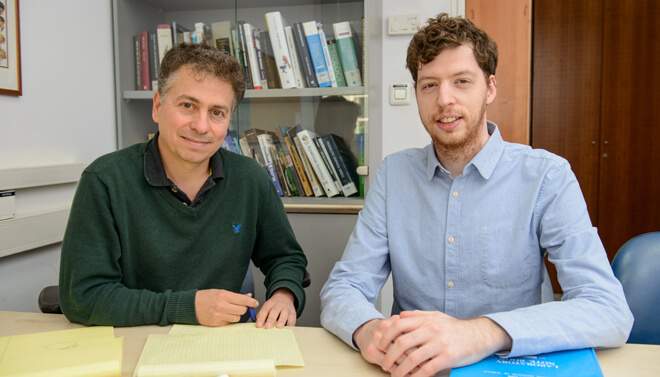Are you a journalist? Please sign up here for our press releases
Subscribe to our monthly newsletter:

Some time ago, the Weizmann Institute’s Prof. Yitzhak Pilpel got a call from his brother. “You are a scientist,” the brother said, “so you should be able to help me resolve an argument I’ve had with my friends: Which came first, the chicken or the egg?”
This conversation led him to publish an essay in Biology Direct, in which he and Tel Aviv University’s Dr. Oded Rechavi argue that in the biological sense, the classical chicken-or-egg dilemma is not a paradox at all. Rather, it can serve as a metaphor that aptly captures the distinction between two types of evolution: Lamarckian and Darwinian.
In the biological sense, the classical chicken-or-egg dilemma is not a paradox at all
In the early nineteenth century, French naturalist Jean-Baptiste Lamarck had proposed that species evolve through the inheritance of acquired traits. In his view of evolution, traits that define a species – say, chickens – emerge during an individual’s lifetime in response to environmental changes and are later passed on to the offspring through the egg or sperm. Pilpel and Rechavi suggest that, metaphorically speaking, Lamarckian evolution is a “chicken first” scenario, in which adaptive changes are passed on to the “egg.” In contrast, in the modern version of Charles Darwin’s theory, new species emerge as a result of genetic mutations that occur in the egg or sperm – which means, again metaphorically, that in Darwinian evolution the egg came first.
Lamarck’s theory was considered completely wrong for nearly two centuries, but lately researchers have begun to discover that in certain cases it might be valid after all. Acquired alterations called epigenetic changes – modifications to the DNA or proteins that don’t alter the basic genetic code – can be passed on to the offspring. The Darwinian option still prevails in nature, so metaphorical eggs in most cases precede their chicken counterparts, but to the extent that Lamarckian evolution also exists, chickens can sometimes emerge first.

Now in another paper, recently published in the journal Cell, Pilpel – together with graduate student Idan Frumkin from his lab in Weizmann’s Molecular Genetics Department, and his former PhD student Dr. Avihu H. Yona, now at the Massachusetts Institute of Technology – has taken the “chicken first” picture one step further by delineating a series of possible explanations for the way in which Lamarckian evolution may be operating on the molecular level. The scientists introduce the concept of a “relay race” that an organism may use to speed up the process of adaptation when life conditions change.
According to their hypothesis, the adjustments organisms make in response to environmental conditions can be presented as a spectrum ranging from short-lived adaptations that don’t affect their DNA at all to long-lasting ones that cause alterations in their DNA code. At the transient end of the spectrum are adaptations that affect gene expression but cause no modifications to the DNA. This happens, for example, when the body manufactures more red blood cells at a high altitude to adapt to oxygen shortage. If the stressful conditions persist over time, the adaptations rise to a new level – the epigenetic one – in which changes can be passed on, even though the DNA itself has not changed. Finally, if the stress persists, it may lead to a mutation – an alteration in the DNA code itself.
Adaptations at one of these stages may set the conditions for the next
In their paper, the scientists propose that adaptations at one of these stages may set the conditions for the next – i.e., “pass the baton” toward true evolutionary change. For example, certain epigenetic changes may roust DNA repair mechanisms; these can occasionally substitute different “letters” in the gene code, causing mutations. When these occur in the sperm or egg, parents pass on to their offspring changes that were assimilated into their DNA during their lifetime, that is, in a Lamarckian manner.
Pilpel and his colleagues believe the relay race may have developed in the course of evolution because it helped organisms adapt quickly to new conditions; but they also suggest that this same race may be exploited by cancer. The extra chromosomes in many cancer cells, for example, are an epigenetic feature that may be a “messenger” in the relay race, increasing the number of cancer-driving genes and spurring on the emergence of mutations that enable the tumor to grow more aggressively.
Prof. Yitzhak Pilpel's research is supported by the Braginsky Center for the Interface between Science and Humanities; and the Sharon Zuckerman Laboratory for Research in Systems Biology. Prof. Pilpel is the incumbent of the Ben May Professorial Chair.